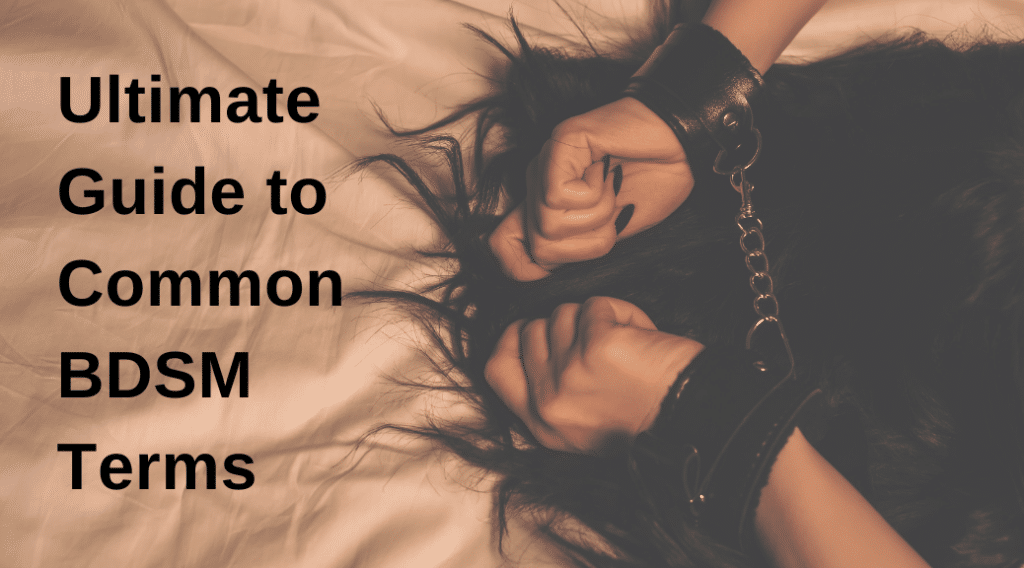Ultimate Guide to Common BDSM Terms

When I first started exploring BDSM, I quickly realized that beyond the dynamics and experiences, there was an entire BDSM language that felt like a secret code. From countless acronyms to nuanced terms, BDSM terminology can be overwhelming, especially for newbies. I remember feeling a bit lost, like I was in a foreign country without a map.
That’s why I’ve put together this BDSM glossary—a high-level guide to the most common BDSM terms you’ll encounter as you explore the community. I’ll also share some specific dominant and submissive terms essential for clear communication and boundary-setting in any power exchange relationship. If you’ve ever found yourself puzzled by BDSM words or simply want to deepen your understanding, this guide is for you. Download your free BDSM dictionary PDF below:

The Importance of Using the Correct BDSM Terms
One of the first lessons I learned in the world of BDSM was the power of words. In a lifestyle where communication is everything, the BDSM terminology we use can make or break an experience. Imagine negotiating a scene and realizing halfway through that what you understood as “soft limits” isn’t what your partner meant at all. Misunderstandings like this can lead to uncomfortable situations or even emotional harm. That’s why using the right terminology is so crucial.
BDSM definitions provide a shared language that helps establish roles, set boundaries, and clarify limits before any play begins. This kind of clear communication builds trust—an essential foundation for any successful power exchange.
Using accurate BDSM language also plays a huge role in making newcomers feel welcome. By learning the correct terminology, I quickly found my footing. It showed the community I was serious about understanding the lifestyle and respecting its practices and rules.
The Risks of an Inaccurate BDSM Glossary
Miscommunication in a BDSM scene isn’t just awkward—it can be downright dangerous. Using inaccurate BDSM terminology can lead to serious misunderstandings that put everyone involved at risk. Take, for instance, the role of a safeword. If you say “stop” instead of the agreed-upon safeword, your partner might interpret it as part of the scene, rather than a signal to halt immediately.
This kind of mix-up can quickly escalate into a situation where consent is blurred, and boundaries are crossed. Similarly, using the term “dominant” instead of “top” may imply that the person has complete control over the submissive partner, which may not be the case in all BDSM relationships.
Additionally, the kink community has long been misunderstood, and the misuse of BDSM language can perpetuate harmful stereotypes. For instance, labeling a consensual, negotiated scene as “abuse” simply because the terms are misused or misunderstood only feeds into the stigma that kinksters have fought against for years. By using an accurate BDSM glossary, we not only protect ourselves and our partners but also show respect for the community at large.
Click here to join our community of 2,000+ Doms and subs!
BDSM Dictionary: Glossary of Common Terms

Now that you know the importance of using the correct terminology, here is a basic BDSM glossary for you to start with:
- Aftercare: After a scene, emotions can run high, and physical needs may vary. Aftercare is the practice of providing emotional and physical support to help everyone come down from the intensity of the experience.
- BDSM: This acronym stands for Bondage and Discipline, Dominance and Submission, Sadism and Masochism. BDSM is a lifestyle that involves consensual power exchanges between individuals. It’s a broad term that covers a range of activities and dynamics, all grounded in mutual consent and trust.
- Contract: A contract in BDSM is a blueprint for the power exchange between a Dominant and a submissive. A BDSM contract outlines the rules, limits, and expectations of the relationship. Some people use formal written contracts, while others prefer a more flexible verbal agreement. Click here to get your free contract.
- DDlg: DDlg stands for Daddy Dom/little girl and represents a specific dynamic within BDSM where one partner takes on a nurturing, often paternal role (Daddy Dom), and the other adopts a more childlike, submissive role (little girl). This dynamic focuses heavily on care, protection, and guidance, with the “little” often engaging in behaviors that reflect a younger, more carefree mindset.
- Dungeon: A dungeon is a dedicated space for BDSM activities. It’s often equipped with specialized furniture, like a St. Andrew’s Cross, a spanking bench, or a bondage bed. Dungeons provide a safe, controlled environment where participants can explore their kinks in a structured setting.
- Exploring: Exploring refers to the process of trying out different aspects of BDSM to discover what appeals to you. Whether new to the scene or looking to expand your experiences, exploring is a way to safely and consensually test your boundaries, learn new skills, and deepen your understanding of your desires and limits.
- Kinkster: A kinkster is someone who enjoys and participates in BDSM or other alternative sexual practices. Kinksters often seek out communities, events, and relationships that align with their interests, embracing a lifestyle that celebrates diversity in sexual expression.
- Rope Bunny: A rope bunny is someone who enjoys being tied up in BDSM play, often as part of rope bondage or shibari. The term is typically used to describe a submissive or bottom who finds pleasure in the sensation and aesthetic of being restrained by ropes.
- Safeword: A safeword is your lifeline in any scene. It’s a pre-agreed word or phrase that signals an immediate stop to the activity. When you hear the safeword, everything halts—no questions asked. This ensures everyone’s boundaries are respected, and that play can continue safely.
- Scene: A scene is the term used to describe a specific BDSM activity or session. It could be anything from a playful spanking to an elaborate roleplay scenario in a dungeon. The scene is where the magic happens, tailored to the desires and limits of everyone involved. Download a free sample scene here.
- SSC: SSC stands for Safe, Sane, and Consensual—a guiding principle in the BDSM community. It emphasizes the importance of safety in play, making sure that activities are performed in a sane state of mind, and, most importantly, ensuring that all participants give informed, enthusiastic consent.
- Switch: A switch is someone who enjoys both sides of the power dynamic. They might take on a dominant role in one scene and a submissive role in another, or even switch roles within the same session.
- Topping from the Bottom: Topping from the bottom occurs when a submissive or bottom attempts to control or manipulate the scene while still maintaining a submissive role. This can involve giving commands, guiding the dominant’s actions, or otherwise influencing the dynamic in ways that blur the lines between roles.
Click the image below to get your complete BDSM Glossary with over 30 terms:

Dominant and Submissive Terms
The D/s lifestyle (Dominant/submissive) is a unique relationship dynamic that can exist completely independently of other BDSM activities. While BDSM often includes power exchanges within its practices, not all power exchange relationships involve traditional BDSM scenes.
Because of this, the D/s lifestyle has developed its own specialized vocabulary to describe the various roles and dynamics within these relationships. Understanding these BDSM terms is essential for navigating the D/s lifestyle with respect and clarity.
Dominant Terms
In the D/s dynamic, the Dominant holds the power and responsibility within the relationship or scene. This role can manifest in various ways, from guiding a partner through a specific activity to maintaining an ongoing authority over the submissive. The following terms are commonly used to describe the different facets of Dominant roles in BDSM relationships:
- Daddy/Mommy: In the context of a BDSM relationship, a daddy/mommy is a dominant partner who takes on a parental role. The daddy or mommy provides guidance, support, and sometimes discipline to their submissive, often called a little.
- Dominant: Often shortened to Dom, a dominant is someone who takes control in a BDSM scene or relationship. The dominant is responsible for setting the scene, giving instructions, and enforcing boundaries. They hold the power in the dynamic, but with that power comes the responsibility to ensure the submissive’s safety and well-being.
- Domme: A Domme is a femme (female) dominant in a BDSM relationship. While the term Dominant is gender-neutral, Domme specifically refers to a woman who takes on the dominant role.
- Master: A Master is a dominant who has complete control over their submissive partner. This term often implies a deeper level of power exchange and commitment, where the submissive, sometimes referred to as a slave, has given up significant or total control to the Master.
- Top: A Top is the person who takes the leading role in a BDSM scene or activity. Unlike a Dominant, a Top may not have ongoing power dynamics with their partner outside the scene. The Top leads and guides the scene, focusing on the physical or psychological aspects of the play.
Submissive Terms
On the other side of the D/s dynamic, the Submissive willingly gives up control to the Dominant. The submissive’s role is deeply rooted in trust and the desire to fulfill the dominant’s directives, all while adhering to the agreed-upon boundaries and limits. Here are some key Submissive terms that you’ll encounter within the BDSM community:
- Bottom: In contrast to a Top, a Bottom is the person who takes on the submissive role during a BDSM scene or activity. A Bottom receives the actions directed by the Top but may not engage in a deeper power exchange dynamic outside of that scene.
- Little: A Little is a submissive partner who embraces a younger persona within the D/s dynamic. This can involve age play, where the Little might act more childlike, relying on their Daddy or Mommy for care, guidance, and sometimes discipline.
- Slave: A Slave is a submissive who has given up complete control to their Master in a BDSM relationship. This term implies a high level of commitment, where the Slave has agreed to serve and obey their Master in all agreed-upon aspects of their relationship.
- Sub: Sub is shorthand for submissive and is often used in casual conversation within the BDSM community. It refers to anyone identifying with the submissive role, whether in a single scene or a more permanent relationship dynamic.
- Submissive: A submissive is a person who willingly submits to the control of a Dominant in a BDSM scene or relationship. The submissive follows instructions, adheres to the rules set by the Dominant, and often finds fulfillment in surrendering their power within the agreed-upon dynamics.
Download the Free BDSM Glossary
Whether you’re a newcomer to the BDSM community or a seasoned practitioner, I hope that this glossary has been helpful in providing a better understanding of the world of kink and BDSM. To make things even easier for you, I’ve also created a free downloadable PDF of this BDSM glossary that you can keep on hand as a reference guide. Just click the image below:

Frequently Asked Questions
Still have questions about the BDSM Glossary? Check out the answers to a few of our most commonly asked questions to learn more.


